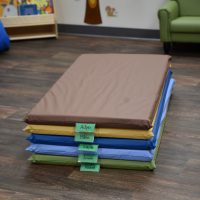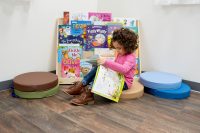
Rest Time: Tips for Creating Safe and Healthy Spaces

Clear Mat Dividers separate mats to ensure the floor side never touches the sleeping side.
Children are wired to respond positively to predictable routines. Rest time is no exception to this rule. When childcare centers, preschools and other kinds of early education classrooms designate specific areas for children to nap, everyone wins. Little ones of different ages will have different needs when it comes to the ideal sleeping environment. Addressing the unique needs for each age group is one of the pivotal elements to providing a safe and healthy sleep environment.
Rest Time for Infants (0-18 months)
Most infants will be on their own sleeping and waking rhythms. A napping area should be provided for infants with individually labeled cribs. It would be convenient if there was a way to get all the infants in one childcare center on the same schedule, but this is probably not realistic. Childcare providers should respond sensitively when infants need to nap.
- Cribs should be placed an adequate distance from each other. Some states will require separate napping rooms while others allow (or require) napping areas to be shared. The first key to success is knowing your state’s childcare licensing regulations backwards and forwards.
- To keep spaces safe and clean, infants should be placed in their own, individually labeled crib with a crib sheet. Make sure the mattress fits tightly in the crib and the crib sheet is snug on the mattress.
- Do not place pillows, stuffed animals, or soft toys in the crib when infants are sleeping. According to the American Academy of Pediatrics (AAP), blankets should also be avoided till babies are at least 12 months old. All these items pose a suffocation hazard. Safe alternatives to blankets are sleepers, sleep sacks, and wearable blankets.
- Wash crib sheets and blanket whenever soiled and at least once per week. (A blanket only applies to infants 12 months and older.)
- Keep sleeping and playing areas separate. If little ones wake up and start making noise, then the quiet, restful environment will be ruined for others who need to catch a few ZZZ’s. Therefore, when kids wake up, it’s time for childcare providers to return them to the play zone.
- Place infants on their backs to sleep and follow all the Mayo Clinics’ recommendations for avoiding Sudden Infant Death Syndrome.

Woodland Rest Mats include plastic name tag holders so kiddos can be assigned their own mat to use each day.
Rest Time for Toddlers (18 months – 3 years) and Preschoolers (3-4 years)
- Provide each child with a cot or mat to nap on. Again, each state’s regulations are different, so it is imperative to know your state’s regulations.
- Store cots or mats in a location away from walkways and in a location where other learning areas can proceed without interference.
- Use a system for designating each child their own cot or mat. For example, name tags ensure children use the same mat or cot each day to reduce the chance of germs spreading from child to child.
- Set up an easy to remember cleaning regimen. Cots and mats should always be cleaned and sanitized before putting them away. Launder sheets daily. Never stack cots or mats with sheets on them since it can promote the spread of germs.
- Mat dividers and dual-colored mats can help keep napping spaces as sanitary as possible. Dual-colored mats allow caregivers to assign one color as the floor side and the other as the sleeping side. This way, children are always napping on the “clean” side. When mats are stacked, Clear Mat Dividers ensure the floor side of mats never touches the sleeping side as an extra precaution.
- Send home personal items like pillows and security items so families can wash them every week.

Our new Microfleece Blanket is soft and cozy but won’t cause kiddos to overheat.
Create a Restful Environment for Children of All Ages
- Do not keep the room overly warm. Make sure infants do not overheat from excessive clothing or crib bedding.
- Never expose children to secondhand smoke.
- Play soft music to lullaby littles to sleep. White noise such as whale calls, rainforest noises, or waves also promotes a restful environment. Whales actually make three types of sounds: clicks, pulses and whistles. Rainforest sounds may include birds chirping or singing, light to heavy rainfall, buzzing, humming, and more! Play background music or white noise softly.
- Dim the lights.
- Keep spaces well ventilated.
- Always supervise children when sleeping.

It’s easy to create the perfect reading nook for quiet time when kids are not apt to nap. Pictured above: Woodland Floor Cushions and a 4-Shelf Book Display.
As children grow older, their need for sleep will change. While it is universal for every child to need both active and quiet times throughout the day, not all will require the same amount of sleep. Little ones may want to merely sit quietly and read, work on puzzles, draw pictures or any number of quiet time activities. Keeping sleeping spaces separate from other learning spaces is usually the best way to ensure those participating in quiet activities are not disrupting those who need to rest. Most parents will be attuned to the specific needs of their children. When childcare centers individualize the care provided by staying connected with parents, then all children will thrive.